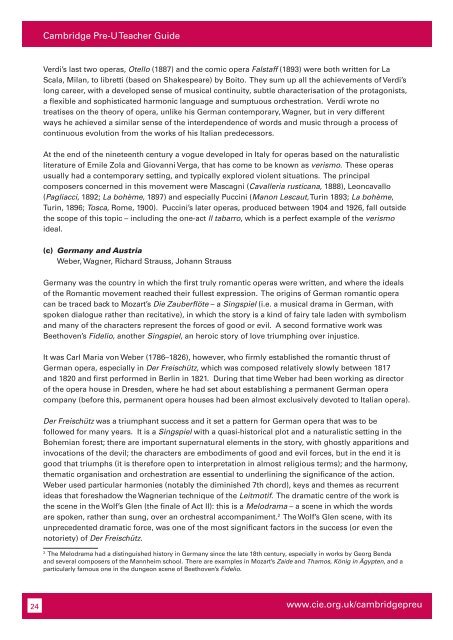Teacher's Guide Cambridge Pre-U MUSIC Available for teaching ...
Teacher's Guide Cambridge Pre-U MUSIC Available for teaching ...
Teacher's Guide Cambridge Pre-U MUSIC Available for teaching ...
Create successful ePaper yourself
Turn your PDF publications into a flip-book with our unique Google optimized e-Paper software.
24<br />
<strong>Cambridge</strong> <strong>Pre</strong>-U Teacher <strong>Guide</strong><br />
Verdi’s last two operas, Otello (1887) and the comic opera Falstaff (1893) were both written <strong>for</strong> La<br />
Scala, Milan, to libretti (based on Shakespeare) by Boito. They sum up all the achievements of Verdi’s<br />
long career, with a developed sense of musical continuity, subtle characterisation of the protagonists,<br />
a flexible and sophisticated harmonic language and sumptuous orchestration. Verdi wrote no<br />
treatises on the theory of opera, unlike his German contemporary, Wagner, but in very different<br />
ways he achieved a similar sense of the interdependence of words and music through a process of<br />
continuous evolution from the works of his Italian predecessors.<br />
At the end of the nineteenth century a vogue developed in Italy <strong>for</strong> operas based on the naturalistic<br />
literature of Emile Zola and Giovanni Verga, that has come to be known as verismo. These operas<br />
usually had a contemporary setting, and typically explored violent situations. The principal<br />
composers concerned in this movement were Mascagni (Cavalleria rusticana, 1888), Leoncavallo<br />
(Pagliacci, 1892; La bohème, 1897) and especially Puccini (Manon Lescaut, Turin 1893; La bohème,<br />
Turin, 1896; Tosca, Rome, 1900). Puccini’s later operas, produced between 1904 and 1926, fall outside<br />
the scope of this topic – including the one-act Il tabarro, which is a perfect example of the verismo<br />
ideal.<br />
(c) Germany and Austria<br />
Weber, Wagner, Richard Strauss, Johann Strauss<br />
Germany was the country in which the first truly romantic operas were written, and where the ideals<br />
of the Romantic movement reached their fullest expression. The origins of German romantic opera<br />
can be traced back to Mozart’s Die Zauberflöte – a Singspiel (i.e. a musical drama in German, with<br />
spoken dialogue rather than recitative), in which the story is a kind of fairy tale laden with symbolism<br />
and many of the characters represent the <strong>for</strong>ces of good or evil. A second <strong>for</strong>mative work was<br />
Beethoven’s Fidelio, another Singspiel, an heroic story of love triumphing over injustice.<br />
It was Carl Maria von Weber (1786–1826), however, who firmly established the romantic thrust of<br />
German opera, especially in Der Freischütz, which was composed relatively slowly between 1817<br />
and 1820 and first per<strong>for</strong>med in Berlin in 1821. During that time Weber had been working as director<br />
of the opera house in Dresden, where he had set about establishing a permanent German opera<br />
company (be<strong>for</strong>e this, permanent opera houses had been almost exclusively devoted to Italian opera).<br />
Der Freischütz was a triumphant success and it set a pattern <strong>for</strong> German opera that was to be<br />
followed <strong>for</strong> many years. It is a Singspiel with a quasi-historical plot and a naturalistic setting in the<br />
Bohemian <strong>for</strong>est; there are important supernatural elements in the story, with ghostly apparitions and<br />
invocations of the devil; the characters are embodiments of good and evil <strong>for</strong>ces, but in the end it is<br />
good that triumphs (it is there<strong>for</strong>e open to interpretation in almost religious terms); and the harmony,<br />
thematic organisation and orchestration are essential to underlining the significance of the action.<br />
Weber used particular harmonies (notably the diminished 7th chord), keys and themes as recurrent<br />
ideas that <strong>for</strong>eshadow the Wagnerian technique of the Leitmotif. The dramatic centre of the work is<br />
the scene in the Wolf’s Glen (the finale of Act II): this is a Melodrama – a scene in which the words<br />
are spoken, rather than sung, over an orchestral accompaniment. 2 The Wolf’s Glen scene, with its<br />
unprecedented dramatic <strong>for</strong>ce, was one of the most significant factors in the success (or even the<br />
notoriety) of Der Freischütz.<br />
2 The Melodrama had a distinguished history in Germany since the late 18th century, especially in works by Georg Benda<br />
and several composers of the Mannheim school. There are examples in Mozart’s Zaide and Thamos, König in Ägypten, and a<br />
particularly famous one in the dungeon scene of Beethoven’s Fidelio.<br />
www.cie.org.uk/cambridgepreu
















